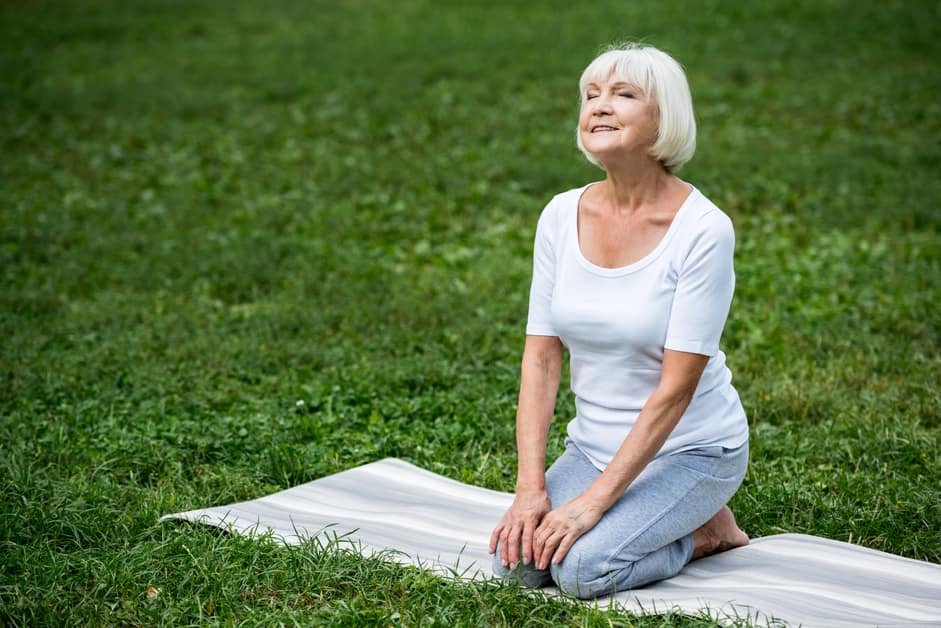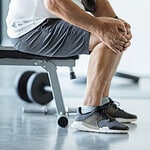Introduction
Knee arthritis can cause pain and debilitation. Fortunately, proof suggests that mind-body techniques can help reduce and manage this pain. These techniques can help you relax and cope with the physical and emotional pain.
We will now explore the many mind-body techniques available. After this, we will look at how you can use those techniques to manage knee arthritis pain:
Definition of Knee Arthritis
Knee arthritis is an inflammatory disorder and a joint deterioration caused by age. It usually happens in adults aged over 55 and is a major cause of disability in the elderly. Different things can cause arthritis pain, such as the lack of cartilage that protects the bones, aging changes in the joint structure, or harm to the ligaments or muscles close to the knee joint.
The main sign of knee arthritis is continuous knee pain, which can be mild or extreme. Additionally, you may feel tightness and/or swelling around the knee joint. While there is no known cure for knee arthritis yet, there are treatments to manage the pain and improve joint function, e.g.:
- Meditation and mindfulness therapy.
Symptoms of Knee Arthritis
Knee arthritis is a term that describes the changes in the knee joint when cartilage wears away. It can be caused by age, obesity, an injury, or too much use of the joint. Symptoms of knee arthritis are stiffness and pain when walking, running, or climbing stairs. You might feel more pain after sitting for long periods or carrying heavy objects. Stiffness can make it hard to bend your knee or walk on rough ground without feeling pain. Swelling, warmth, and popping noises are also signs of this condition.
Moderate to severe cases show more symptoms like:
- Inflammation of nearby soft tissues
- Crepitus (grating) under the skin
- Difficulty straightening the leg
- Weakness and instability
- Decreased range of motion
- Bone spurs
- Redness and warmth around the area
- Gelling sensations
- Clicking during movement
- Tiredness with short walks
- Flare-ups in cold/damp weather
If you have any of these symptoms, see a doctor to find out if it’s knee arthritis and if treatment is needed.
Mind-Body Techniques for Managing Knee Arthritis Pain
Mind-body techniques, like yoga, meditation and self-hypnosis, can be super helpful for managing chronic knee arthritis pain. They work by helping you be more relaxed, reducing stress and changing your focus away from the pain. You’ll not only get a great distraction but these techniques can also reduce inflammation and improve joint movement.
In this article we’ll go over the different benefits of mind-body techniques for knee arthritis pain relief:
Mindfulness Meditation
Mindfulness meditation is a way to manage knee arthritis pain without drugs. It’s about noticing and accepting the here and now. It lessens pain and boosts physical function.
The aim of mindfulness is to be aware in the moment and cease negative cycles, such as ruminating about pain. It encourages us to label emotions, sensations and thoughts with kindness and no judgement. This lessens emotional distress and strengthens resilience to deal with chronic knee arthritis pain.
Mindfulness can be sitting or moving, based on preference and physical capacity. It focuses on breath, bodily sensations or sounds to nurture present-moment awareness. It’s a great option for those wanting to try something other than medication to treat knee arthritis pain. It helps them take charge of their health through mental relaxation techniques.
Visualization
Visualization is a technique that uses imagination to achieve desired outcomes. It can be used with relaxation or without, as research shows it reduces pain for those with knee arthritis. Visualize calming images, like a beach or a mountain meadow, to help move away from pain thoughts. This also assists in accepting and relaxing physical and emotional distress.
To use visualization for reducing knee arthritis pain, follow these steps:
- Find a comfortable spot to sit or lay down.
- Close your eyes and take some deep breaths, releasing tension from your body.
- Picture the scene in your mind’s eye – its sight, smell and feel. Add as much color and texture as possible.
- Focus on the scene, which should lead to relaxation. Imagine being healed or letting go of pain and stress.
- Stay focused for a few minutes before opening your eyes when done.
Relaxation Exercises
Relaxation exercises are a great way to manage knee arthritis pain. These activities involve deep breathing, muscle visualization, progressive muscle relaxation, yoga, and tai chi. They use relaxation and self-awareness to release physical tension and mental stress.
Take deep breaths in through your nose, all the way down to your stomach, and exhale slowly through your mouth. This will help you to relax your body and mind. You may also practice mindful or guided imagery techniques. Imagine yourself in a peaceful setting, such as a beach or a forest. This will help create feelings of calmness and cope with the pain.
Progressive muscle relaxation is another exercise. Tense then relax each body part gradually, from head to toe. This helps target and release areas of tension throughout your body.
Yoga and tai chi are beneficial for treating chronic knee arthritis pain! These activities use specific postures and deep breathing. This can reduce stress hormones and improve flexibility, range of motion, and joint stability around your knees.
Benefits of Mind-Body Techniques
Mind-body techniques can be helpful for handling the discomfort connected with knee arthritis. They emphasize creating a sense of relaxation, mindfully being present, and staying connected to your body. These skills can benefit both your emotional health and physical wellbeing. With consistent use, you can be aware of changes in your body and manage the signs of knee arthritis better.
Below are some of the distinct advantages of mind-body techniques:
Reduced Pain
Mental and physical health are linked. Mind-body techniques can help recover from a knee injury. These techniques are known to calm and reduce pain. Mind-body techniques include: meditation, yoga, guided imagery and deep breathing. This helps individuals become aware of their body and how it experiences pain.
With these techniques, people with arthritis often have less knee pain in the long term. Mind-body techniques can be used with medications, such as NSAIDs, acetaminophen or opioids. Improved sleep quality may also result.
Overall, mind-body interventions provide control over well-being and better physical functioning despite arthritic deterioration.
Improved Mobility
Yoga and meditation are popular for relaxation. But the benefits are much more! They can improve physical abilities and mobility.
Yoga uses your bodyweight to gradually stretch and strengthen your muscles. This combination helps maintain healthy posture alignment, reducing pain. With regular practice, you may experience better performance in physical activities and increased dexterity.
Mind-body techniques also help with injury prevention. They strengthen stabilizer muscles which often go neglected! Relaxation promotes better posture and corrects body imbalances caused by stress. With mindful stretching exercises, we get a foundation of stability. This helps protect our joints from wear or tear due to incorrect posture or lack of flexibility while running or cycling.
Regular practice of mindful movements and postures targeting hips, shoulders and neck can help us move through life without aches or stiffness.
Improved Quality of Life
Mind-body techniques benefit both physical and psychological health. Doing them as part of a group or alone can lead to better quality of life.
Physical benefits include relaxation, better cardiovascular health, better sleep, stronger muscles, better posture and more flexibility. They also help reduce pain and ease tense muscles.
Mental benefits include better stress management, more confidence, more clarity and focus, better handling of emotions, increased spiritual awareness and more connection with oneself and others. This connection leads to greater empathy and compassion. Studies have also shown increased levels of optimism from regular use of these techniques.
How to Get Started
Suffer from knee arthritis? Seeking a way to manage pain, but not medication? Mind-body techniques could be the answer! They provide a way to self-manage pain and have been found successful in treating chronic pain. Here are some tips to get you started:
- Practice deep breathing and meditation.
- Engage in gentle physical activities, such as yoga and Tai Chi.
- Consider talking to a therapist or counselor.
- Seek out support from a group of people with similar conditions.
- Make sure to get enough rest and sleep.
Find a Qualified Instructor
Having a qualified instructor is vital when using mind-body techniques to ease knee arthritis pain. Look for a licensed physical or occupational therapist with proper certifications in mindfulness instruction, biofeedback, and/or integrative medicine. It’s best if they have personal experience with joint pain and have used these techniques to manage their symptoms.
Furthermore, it’s important to work with someone who understands the physiology of both physical and mental pain caused by arthritis and other chronic conditions. This instructor should be able to explain the physiology of the condition and provide resources on the latest research in this area.
You can find instructors through your treating physician’s referral or online searches for certified practitioners of integrative medicine. Many hospitals also employ integrative practitioners who are trained in mind-body techniques for chronic illnesses like arthritis. Having a qualified instructor is essential to maximize the efficacy of your treatment plan and get informed guidance.
Practice Regularly
To make changes in body and mind, practice regularly. Repeating is key for moving from conscious effort to unconscious effort. Make a plan that suits your lifestyle, and set realistic goals.
If you’re new to mind-body techniques, begin with 10-30 minutes, 3 times a week. This gives the connection time to develop, then you can increase frequency.
Find a comfortable position that allows the flow of breath or energy. Close your eyes and focus on slow, rhythmic breathing. Relax each part of the body, starting from head to toe. Spend several minutes in this posture.
Then move on to other practices like:
- Guided visualization
- Progressive muscle relaxation
- Yoga
- Mindfulness meditation
- Tai chi movements
With repetition over time, these techniques can change how the brain processes pain signals. This could relieve symptoms and enhance physical functioning and quality of life.
Conclusion
To sum up, using mind-body techniques to manage pain from knee arthritis can be effective. Yoga can help increase flexibility and strengthen muscles around the joint. Tai Chi and Qi Gong help promote mental clarity and physical balance. Mindfulness practices, such as meditation and deep breathing exercises, reduce anxiety and stress, both of which affect arthritis symptoms.
When using these treatments, it’s important to remember that they won’t provide an immediate fix or cure the pain. But with regular practice and dedication, noticeable improvements may be seen over time.
Frequently Asked Questions
Q1: What are mind-body techniques?
A1: Mind-body techniques, such as meditation, yoga, and tai chi, are practices that incorporate physical and mental exercises to help improve overall wellbeing. They promote relaxation and reduce stress, which can help manage pain associated with knee arthritis.
Q2: How can I start using mind-body techniques?
A2: You can start using mind-body techniques by finding a practice that works best for you. You can take classes, join a group, or practice on your own with instructional videos.
Q3: Are mind-body techniques safe for people with knee arthritis?
A3: Yes, mind-body techniques are generally safe for people with knee arthritis. However, it is important to check with your doctor before beginning any new exercise program.





